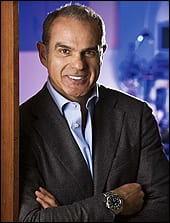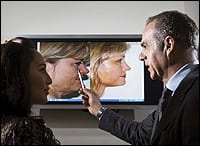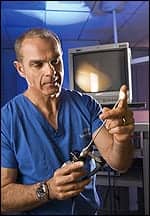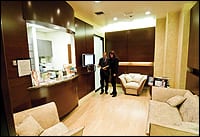
I grew up in a small town between the border between Italy and Austria and we learned German in school. I planned to come to medical school, so my dad was planning on sending me to London to learn how to speak English—when I was 18 as a graduation award.”
Renato Calabria, MD, raises his head slightly to one side, as if pulled into a special memory. Around him are the trappings of a man whose practice takes him from Beverly Hills near Rodeo Drive to Rome and other locations in Italy in which to perform surgeries. His Beverly Hills office has a modern, crisply European feel to it.
“I had a great aunt who was visiting us in Italy from Pacific Palisades [Calif],” he continues. As he sits at his desk in a nicely apportioned private office, he adds, “She said, ‘What? Forget it. Send him to Los Angeles.’ So, that summer when I graduated from high school I spent 3 months in the summer in LA. I fell in love with it, and then I kept coming.”
Calabria’s father objected to the expense of regular trips to California. “I managed to formulate a way that I could come here on some externships, and my dad would never complain if it was an investment for education. I kept on coming for five summers in a row, doing some externships at UCLA, USC, etc. When I went back to Italy and I graduated from medical school, I did my internship there and so I kept my license there, which comes in handy now that I go back and do surgery there.”
After this, Calabria returned to the States and sought further training.
Back in the present in Beverly Hills, the afternoon sun grows hazy. Calabria has done what many are referring to as pioneering work in the use of adult stem cells in facial plastic surgery. The man runs a very successful boutique practice catering to a clientele of Hollywood stars. Nonetheless, he has retained his humility, built no doubt on the experiences in the United States that shaped his training.
Speaking in nostalgic tones, he describes the challenge of being a foreign medical student. “We’re talking about the early ’80s. There was already a plethora of people applying to residencies all over the country. For the foreign students, it was hard to get in,” he notes. “I started doing some research, a fellowship at UCLA Surgery, published some papers. Got my foot in the door.”
At the time, he planned to specialize in surgical oncology, with 2 years of pathology to get a background in surgical oncology followed by 5 years of general surgery. He did an externship in cardiac surgery, and soon thereafter an externship in plastic surgery at Saint Francis in San Francisco Medical Center.
The “duck came down,” and the magic words were plastic surgery. “I found my true calling,” he says.
Afterward, he put in another 3 years of training in plastic surgery in San Francisco, which he describes as “a fantastic program and really got me close to what I like to do best, which is cosmetic surgery,” he says. “We had a fantastic teaching staff. We were rotated through a number of teaching staff all over the city. We got a wonderful experience. In their training program [is] where I started doing facelifts.
“I did more than 20 facelifts on my own while I was in training, which is almost unheard of for a plastic surgery resident. Usually, the experience you get is limited, but I was lucky enough to do that many. I was going to stay up in the San Francisco Bay Area, but my wife is from Beverly Hills so I decided to move back to LA, where I started.”
CUTTING TO THE CHASE
Calabria lives at the cutting edge of the best of all worlds. He develops new procedures in the more progressive European Union and eventually uses them in the United States, when the FDA approves of their use.
 |
| Calabria’s most recent work includes the Cell Enhanced Face Lift, a procedure that involves the use of stem cells. |
His most recent work includes the Cell Enhanced Face Lift, a procedure that involves the use of stem cells. The procedure is in use in Italy. He is counting any day now on FDA approval for the procedure’s use in his Beverly Hills office.
The diversity of a global enterprise offers many advantages, he says. “I have offices strategically in places like Rome, Milano, Rancho Mirage, and Los Angeles. You settle in a place that you like, and then you devote your time to build your practice. It’s nice to be in an area where there are affluent people who can afford to get plastic surgery.”
Having offices in all his favorite cities might be enjoyable, but it has also proved to be a smart business move to stay ahead both financially as well as technologically. If the business dips in one area due to a downfall in the economy, his business can remain steady by turning more attention to the other geographic areas.
“It’s fun to have practices in both Europe and [in the US] because one of the main differences is that even though we have seen a drop in our cases in the United States, in Europe they have a more conservative approach. In fact, there is a recession there, but it’s a little milder and people have not overspent,” he adds.
Whereas the FDA regulations are more restrictive, Calabria can find the flexibility he needs in the more lenient and experimental-friendly European market. He also enjoys bringing the Hollywood/Beverly Hills cutting-edge techniques to Europe. In the United States, “you have to be on the top all the time, and you can’t afford to fall behind on anything because the competition is so high,” he notes.
STEM CELL FACELIFT
 |
| One-half of plastic surgery is in the technology and the other half is left to the surgeon’s aesthetic taste, to his sense of beauty, Calabria says. |
Calabria is careful to first point out the distinction of using adult stem cells as opposed to embryonic stem cells, which are the center of controversy. “We know now with the new administration, there’s been a little bit of an opening of research for embryonic stem cells,” he says. “But embryonic stem cells are not a focus of interest as this time. We’re focusing more on adult stem cells.”
How did he create the Cell Enhanced Face Lift? “About a decade ago, we discovered that there were adult stem cells present in a body in a sort of dormant state, and they get reactivated when they get a signal from our body,” he says.
Ironically, a rich source of these adult stem cells is found in fat. “Some of the skin texture improves with fat grafting alone, so we started thinking why this is happening. We are postulating right now that obviously these adult stem cells they have a sort of a regenerative capacity. They actually regenerate tissues and increase blood vessels and increase blood flow into the skin, and that’s why the skin looks better,” he continues.
“We’ve been using fat grafting for the last 10 years, with some sort of a success, but really we call it always, ‘technique dependent.’ What does that mean? In fat grafting, the problem is longevity. In some fat grafting, 80% to 90% gets reabsorbed. Some of it lasts longer, and we really don’t know why. Also, I’ve seen cases in which patients had fat grafting done in the face and they gained weight. When you gain weight, the fat cells increase. It’s kind of a double-edged sword. I’ve seen patients looking a little bit bizarre after gaining weight after fat grafting.”
Longevity of fat grafting poses an issue independent of the surgeon performing the procedure. However, another part of fat grafting is very much reliant on the skills of the person performing this specialized technique.
“In plastic surgery, what is fun and what is great about it is that half of that is the new technology and half of that is left to the plastic surgeon himself—to his aesthetic taste, to his sense of beauty, to his technique,” Calabria says. “There’s never one solution; there’s always three or four or five. And that’s what I like. It’s your interpretation that makes it fun. It’s important to combine the talent with having that technology. If someone is closed to new technologies and new ideas, they’re sort of left where you were when first they trained. If you have only a hammer, then the whole world looks like a nail. I like to offer everything and pick and choose the best to use. It’s useless to put fat grafting on a round face. But if I used fat grafting all the time, then I would use it even in that case.”
It is the art of making the right choices for his patients. One example of this is in knowing how to say no. “It’s very stressful dealing with celebrities,” he admits. “But I started dealing with them early on. It’s hard to say no to a celebrity when they ask you. It’s hard to say no, you don’t need it. Look at Michael Jackson. Celebrities have a lot of time on their hands and it’s really a competitive world, but there’s nothing worse than an overdone celebrity.”
WORKING WITH HIGH-TECH
 |
| Calabria’s well-apportioned Beverly Hills-based office has an invitingly crisp, European feel. |
Calabria mentions a new branch of medicine called regenerative medicine. “It is going to look at the role of regenerative cells and how to use them in regenerating tissues, not only in plastic surgery but in medicine,” he explains. “Cardiac surgeons are looking at how to use cardiac stem cells to regenerate healthy muscle tissue after a heart attack. Scientists are also using stem cells to try to regenerate tissue after a stroke and to help people with diabetes.
“We can actually treat it through a complicated process,” he continues. “It sort of washes out debris and then washes out the fat cells, and then concentrates what we call regenerative cells. In fat cells, there are not only stem cells, but also there are cells produced in growth factor and there are cells producing blood vessels. Grouped together, they are called regenerative cells.”
To “wash” stem cells out of adult fat, Calabria uses the Celution device from Cytori Therapeutics, San Diego. With this device, “the regenerative cells present in the fat are being concentrated about 10 times as much as the regular fat,” he says. “There are two ways to go. One is using them as pure regenerative cells to reinject. The other is mixing it again with fat and creating a so-called turbo-charged fat cell, in which the stem cells are in highest concentration—much more concentrated than any regular fat. This allows the fat to actually not be reabsorbed as fast, so the longevity of the fat grafting is enhanced and the results are improved. Again, there is the highest concentration of stem cells and regenerative cells. I used this device in Italy for the first time about a year ago. And I was one of the first ones to actually do what we call a stem cell facelift using this technology.”
According to Calabria, the process is as follows: harvest the fat, process the fat via the Cytori device, retrieve only the concentrated “washed” fat, and perform the facelift.
In addition, he has found more than one way to use these harvested regenerative cells—use them in combination with the facelift for volumizing, he says, although he adds that he has not done this yet.
“I’ve done a lot of fat grafting,” he notes, “using small tiny incisions and injecting the stem cells in the same way. That is a little trickier because the placement has to be very precise, and with the procedure with the facelift you can actually place it very precisely under the muscle in the areas that you want to.”
As he performs his facelift technique, Calabria says the placement of the fat cells is extremely important. “The stem cells have to place in a highly vascularized area and under the muscle, so they have a better potential to stay and prosper there. I’ve done about a handful of cases, and I’ve seen some great results. I notice right away [that] the texture of the skin has improved. Not only is it a volumizing procedure but also there’s a topical difference in the texture of the skin.”
In the cases that he has done, what parts of the face are more receptive to the reinjection of fat cells? “I think the cheek area is wonderful. You get a super volume and texture improvement,” he says. Initially, in the first 2 weeks after the procedure, “the patient looks phenomenal,” he adds. “They have that swelling that kind of makes all their lines go away.
“In the first few cases, I was very conservative in using it, but now that I have more experience I think I can use it in a more aggressive way to get even better results,” he says. “We’re making progress, but we’re still at the beginning of this process, so it’s important to emphasize that we shouldn’t just make statements that are maybe not true in the future.
“I think that the potential of this [technology] is very great. I’ve seen a fantastic result even in acne scars with the stem cells. There is a really wide potential of treatment alternatives with this technology. We’re seeing a regeneration of the tissues, and that’s what’s really exciting about it. Because then we have a tool that, in combination of facelift or through injection alone, will allow us to really maybe ‘turn back the clock’ in one way.”
The limitations of using stem cells in cosmetic surgery? “This technology is still time-consuming because it takes about 2 or 3 hours to isolate the stem cells and then reinject them,” he says, emphasizing that the technology shows great promise but is also a technology that should be used in the operating room, in order to accommodate the best sterile conditions.
He would like to see some manufacturer develop less bulky hardware to process the fat. “Then we could do [the procedure] as an outpatient, but maybe in the office itself, like you do with a collagen injection,” he notes.
In the future, the device may be used not just for facelifts but also for breast augmentation. However, Calabria points out the hype surrounding the use of fat grafting. “There are a lot of cases done already for breast reconstruction; after radiation, after lumpectomy, etc. But mainly you should apply this, it has to be done with caution and by gathering data because the breast is an organ,” he says.
“It’s very important not to create artifacts which can be interpreted to be cancer and stuff like that. You inject fat and then fat can go into the crevices, which means it can create some modularity. If you have an issue in which you don’t know which one is the fat and which one is the cancer, then it’s problematic. The radiologists are getting really very sophisticated in recognizing what are the characteristics of cancer versus fat masses. That will bring us to use the fat grafting as more of a tool in augmentation cases.”
Caution is very important in approaching fat grafting to the breast and more data is needed, Calabria notes. “We should really treat this field as experimental,” he warns.
WHEN IN ROME…
Government regulation is the main difference between working in the United States and Europe, according to Calabria. Europe is “a little less tight,” he says. “Therefore, companies that are on the cutting edge can really take advantage of that. Maybe because it’s not as well regulated, which can be detrimental at times, in this case it’s good. It’s good that we have the experience on the European front and we can relate the data and then put it together for the American FDA. Europe is a good ground for gaining experience, to get new things going.”
If the technology was found to not be effective and safe, the legality of the American system would not be forgiving. “When you’re on the cutting edge, you’re always taking some slack. If you had talked to plastic surgeons 10 years ago and you said, ‘I’m going to do fat grafting to the breast,’ they’d have said, ‘Are you kidding me?'”
More recently, these approaches are becoming more accepted in the United States as the data comes in from Europe. However, Calabria says that American-centric research and data is critical to acceptance.
Shelli Merrill is a contributing writer for PSP. She can be reached at [email protected].






